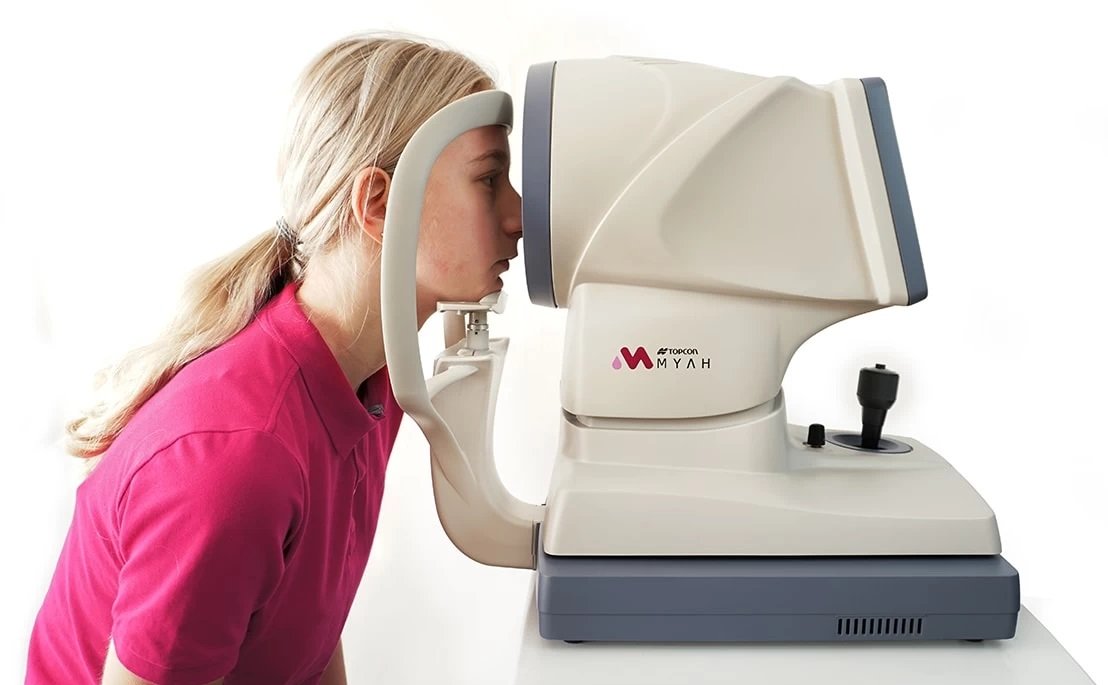OUR SERVICES
Latest Technology in Eyecare
Axial Length Measurement
We include an axial length measurement on all children’s exams with our new instrument, the Topcon MYAH.
The Myah device is specifically designed for axial length measurement, the most accurate and reliable way to track childhood myopia progression.
In addition to axial length, Myah also measures corneal shape, topography, and other biometric data used for myopia management.
Myah allows us to:
Measure and track axial length growth over time
Predict future refractive error changes
Evaluate treatment effectiveness
Personalize myopia control strategies (ortho-k, atropine, specialty lenses)
Because axial length is the most important indicator of long-term myopia progression, Myah plays a central role in our myopia management program.
Reasons your optometrist would do an axial length measurement:
To determine your child’s probability of becoming nearsighted (or myopic)
To aid in understanding if the myopia management treatment approach is working
Help parents to understand why myopia management is needed or necessary
VISUAL FIELD TESTING
Our optometrists may recommend you to have your peripheral vision checked. At View Optometry we can do this by using an instrument called a visual field. You may also require a visual field test for your driver’s license. This additional testing would be fully covered by your B.C. Care Card.
Visual field testing is essential for detecting and monitoring:
Glaucoma
Optic nerve damage
Neurological conditions (stroke, pituitary tumors, brain lesions)
Medication-related vision changes
This test is quick, non-invasive, and critical for identifying blind spots or visual pathway issues that cannot be detected during a routine eye exam.
Reasons the optometrist may want you to perform a visual field test:
If the doctor suspects you may be developing glaucoma
If you have a family history of glaucoma
If you had or the doctor suspects you have had a stroke or tumor in the brain
If you have an ocular disease that affects the optic nerve
To determine if a lid droop is affecting your vision
To obtain to driver’s license
Baseline testing
Ocular Coherence Tomography (OCT)
What is an OCT?
An OCT uses light waves to take a scan of the back or front of your eye. It is similar to an ultrasound image in that it takes a cross section image of a part of your body with non-invasive techniques. Every eye exam at our clinic includes an OCT scan of your eyes.
This technology helps diagnose and manage:
Glaucoma
Macular degeneration
Diabetic retinopathy
Retinal swelling and structural abnormalities
The OCT also provides 3D imaging, RNFL (retinal nerve fiber layer) analysis, ganglion cell layer measurements, and progression reports, offering unparalleled insight into ocular health.
Reasons the optometrist may want to take an OCT scan of your eyes:
If the doctor suspects you have a retinal disorder, glaucoma, or a corneal disorder
To monitor progression of an eye disease
If you have diabetes
If you have a family history of macular degeneration
Baseline testing
Meibography
Meibomian glands are found within the eye lids. We use our Topcon Myah to take an image of these glands. They produce an oil called meibum which is the outermost layer of the tear film. If they are clogged up you can get dry irritated eyes or even styes.
Reasons your optometrist would do meibography:
To determine if your meibomian glands are blocked
To aid in understanding if the treatment approach is working
As a demonstration tool to patients
This technology helps us diagnose and manage evaporative dry eye, blepharitis, ocular surface disease, meibomian gland dysfunction, contact lens–related dry eye, and more.
Cornea Topography
Corneal topography is like a map of the surface of your cornea, the clear front part of your eye. It shows how curved or flat different areas of the cornea are.
Reasons your optometrist would do topography:
To screen for a cornea disease called keratoconus which is common in patients with high astigmatism
To perform specialty contact lens fittings
Often needed prior to refractive surgery to determine if you are a good candidate for the surgery
Our investment in advanced diagnostic technology ensures:
Earlier identification of eye disease
More accurate diagnoses
Precise biometric measurements
Highly tuned myopia management
Objective dry eye evaluation
Better long-term monitoring
More effective, customized treatment plans
A more comfortable, efficient exam experience
We combine technology with personalized care to safeguard and optimize your vision.




